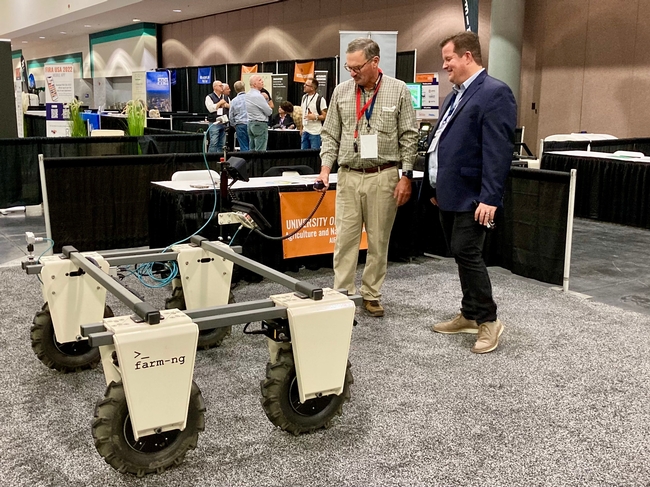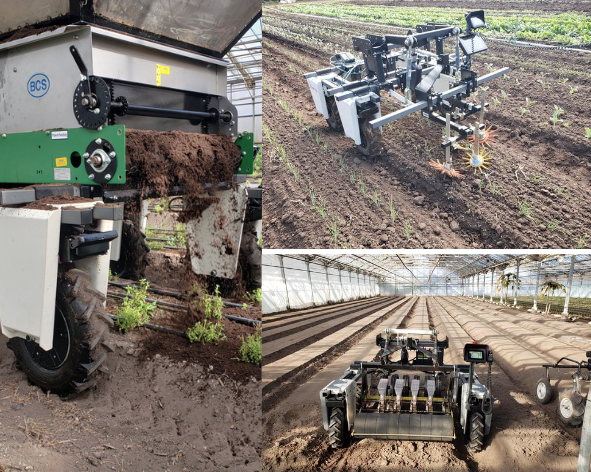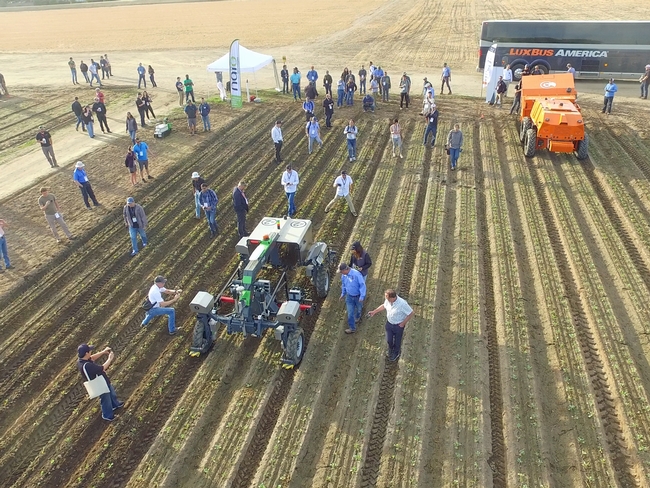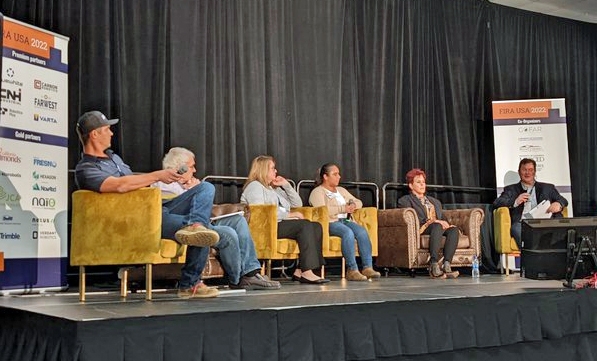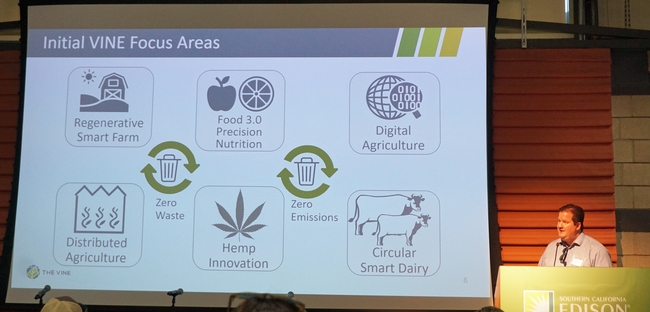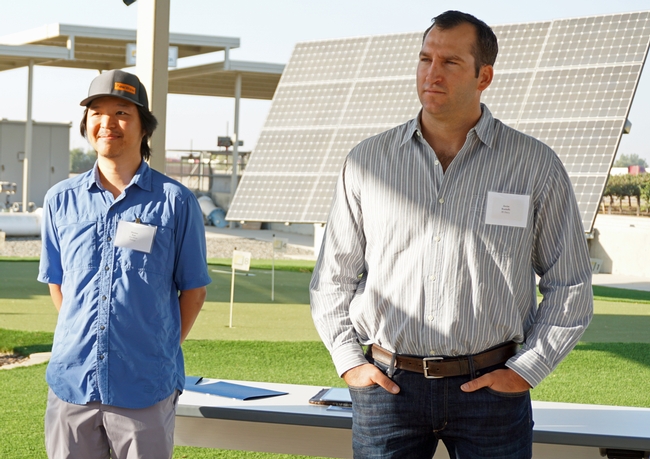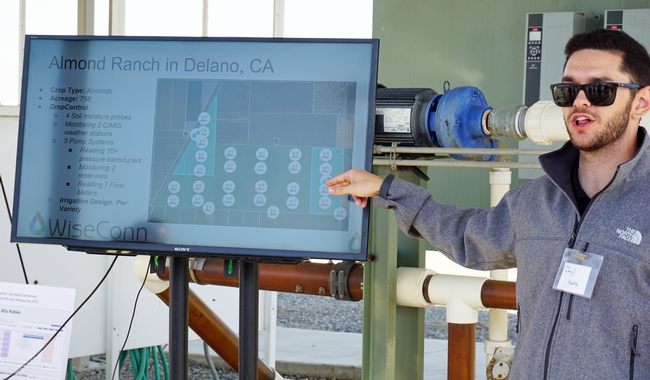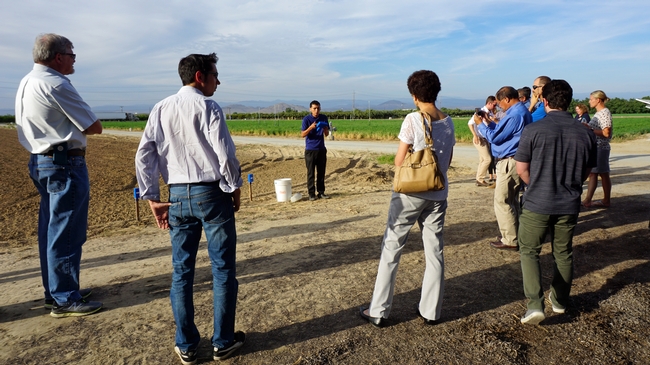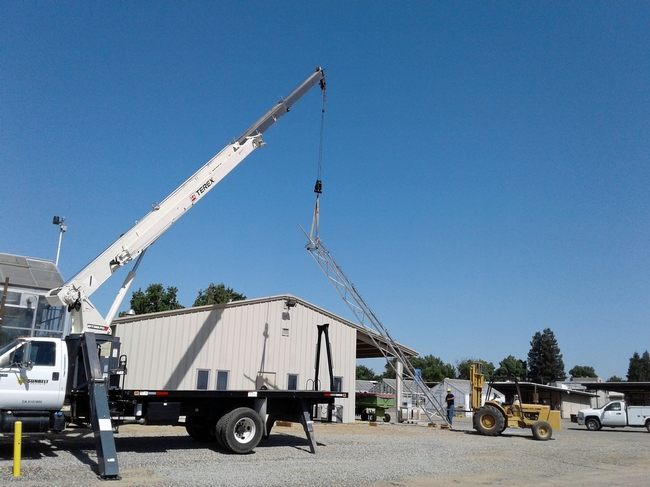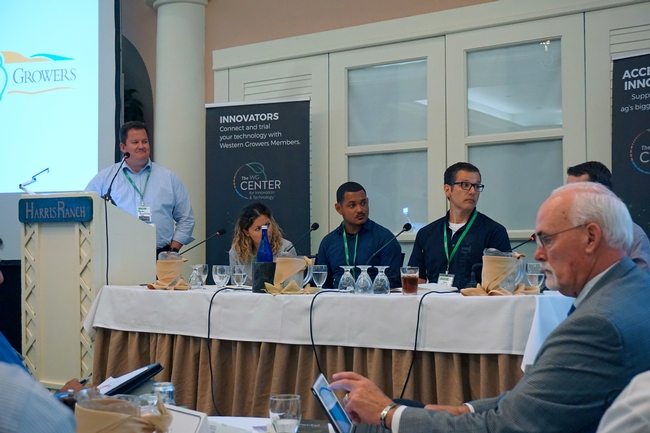Posts Tagged: Gabe Youtsey
Farm robotics competition challenges students to solve real-world problems
College students are invited to develop a robot that makes farm work easier while competing for cash prizes and bragging rights in the Farm Robotics Challenge, a three-month robotics development competition running from Feb. 1 to May 13, 2023.
The challenge is being sponsored by The VINE, an initiative of the University of California Agriculture and Natural Resources focused on agricultural innovation, in partnership with the AI Institute for Next Generation Food Systems (AIFS), farm-ng robotics company, and the Fresno-Merced Future of Food (F3) Innovation coalition.
"Our primary objective for the Farm Robotics Challenge is to empower young innovators to explore careers in agriculture technology and innovation," said Gabe Youtsey, chief innovation officer for UC ANR and head of the VINE. "The agrifood technology industry is one of the most exciting and fastest-growing sectors in the economy right now, estimated to reach $30.5 billion by 2050. Yet, because of a lack of exposure or access, our brightest minds end up entering other sectors, taking their talents and abilities with them. We hope this new competition changes that and reverses the talent flow back into agriculture."
“In order to have a next-generation food system, we need next-generation agricultural robotics developers,” said Steve Brown, AIFS associate director. “There is tremendous innovation potential in this domain that just needs more connecting points to the coders and makers.
The Farm Robotics Challenge is open to any university or college in the U.S. Student teams will be asked to address a production farming topic on any crop or size of farm, with a desired focus on small farms, by automating an essential farm-related task using the farm-ng robotics platform. Each campus will need to purchase a farm-ng robot or borrow one to participate in the challenge.
Specific challenges will either be pre-identified for teams to choose from, or teams may choose to create additional or custom functionality to solve a self-identified challenge. Challenges will fit into one or more of the following categories: autonomy, artificial intelligence or attachment. Virtual training sessions will be offered throughout the competition to provide teams with expert guidance and technical help from AIFS, farm-ng, The VINE and other partners.
Student teams will be judged on the following criteria, with a grand prize and several specific prizes for top teams in each category: accuracy and completeness, market fit and commercial potential, design elegance and ease of use, cost-effectiveness, safety, interdisciplinary inclusion, and social and economic impact. Winners will receive cash prizes and connections to robotic companies for internships and jobs, among other benefits.
For more information, please visit the Farm Robotics Challenge website at https://farmbot.ai. If you have questions, contact HannaBartram, AI Institute for Next Generation Food Systems education and public engagement coordinator, at hcbartram@ucdavis.edu.
First FIRA USA Ag Robotics Forum attracts people from around the world
Agriculture and the global food supply is threatened by a range of issues including drought, climate impacts, increasing business costs and labor scarcity. To forge solutions to these issues and more, nearly 1,000 attendees from 26 countries converged in Fresno on Oct. 18-22 for the inaugural FIRA - World Ag Robotics Forum to be held in the U.S. The event was co-sponsored by UC Agriculture and Natural Resources' The Verde Innovation Network for Entrepreneurship, or the VINE.
Widely observed as a pivotal moment for agricultural technology and robotics in U.S. agriculture, the event was kicked off by California Department of Food and Agriculture Secretary Karen Ross and moved into a packed agenda with panel discussions, lightning talks and pitches where automation company representatives, academics and growers had the opportunity to share their challenges, concerns and hopes for the future of autonomous farming. The event culminated at CSU Fresno with more than a dozen companies offering in-the-field demonstrations.
Although growers are the target market for most of the equipment, the benefits of automation can ripple out into society, according to Glenda Humiston, University of California vice president for agriculture and natural resources.
“Technology can help us grow, harvest and distribute food more efficiently so that it can become more affordable and accessible for those who are food insecure,” said Humiston. “If we do this right, it's good for the whole community.
Here are a few themes and takeaways from this pioneering multi-day event.
Gaining on-farm use - Focus on end-user needs and ease of use
A major question speakers tackled was why more growers aren't yet integrating automation on their farms. Automation solutions exist and are being developed to help growers in nearly every aspect of running a farm — from planting, harvesting and weeding to addressing persistent labor shortages. Despite this, ag automation companies – both big and small – still face resistance from growers to adopting new technologies.
Part of the problem, Jeff Morrison of Grimmway Farms said during a panel on mechanization versus automation, is that companies pay more attention to their product than the needs of the grower. “Farmers want technology that fills a particular need,” he said. Anna Haldewang, the founder of InsightTRAC, agreed. “Don't be married to your product, be married to your customer.”
Chuck Baresich, president of the Haggerty AgRobotics Company, emphasized the importance of creating automation solutions that are simple and intuitive to use. “For a manufacturer, the first thing I'd tell them is don't overcomplicate things,” he said. “Make sure your robot can drive straight, start with that.”
Panels also touched on the technical, business and regulatory challenges to automating agriculture. The ag tech startup market is much younger than Silicon Valley, and we don't yet know the best route to establishing a successful business, Rob Trice of Better Food Ventures and The Mixing Bowl observed during a panel on robotic product development with key industry leaders, including Walt Duflock, vice president of innovation for Western Growers. That said, panelists identified three things that startups should do:
- Get prototypes into the field as quickly as possible to get performance data and get feedback, including from farmworkers, who may come up with multiple uses for the product.
- Be transparent about development to build partnerships with investors and growers. Partners understand that startups are a work-in-progress.
- Be ready to evolve and change your technology or your business to meet the customers' needs. Love the customer, not the tech.
AgTech, Labor and Farmworkers - Forging win-win opportunities
Labor issues also emerged as a persistent theme during the event. One of the major forces driving the need for automation in agriculture is persistent labor shortages. Simply put, farmers do not have sufficient labor to sustain their operations and are turning to agtech, robotics and automation to fill the gap. At the same time, as robotics and automation take hold in the agriculture industry, farmworkers and farm labor organizations are rightly concerned about the impact that the adoption of automation will have on agriculture jobs, in particular farm labor jobs.
Hernan Hernandez of the California Farmworker Foundation acknowledges the labor concern, but also sees opportunity. “All of a sudden, you go from 100 individuals that are going to be able to harvest this season to now 10 that will harvest with a machine," he said. "But the way we look at it is as well, when we talk to farmworkers and engage them, and we look at data, there is also opportunity. We know a lot of the farmworkers want opportunities to further their skill sets.”
We've got to find ways to help our farm workers actually get the training they need to make use of this technology, which will give them a better quality of life.
This sense of optimism about the future of the farmworker was shared by Gabe Youtsey, chief innovation officer of UC ANR, who moderated a panel on the future of agricultural work. “California as a whole has begun recognizing the importance of creating the next generation of ag workers,” he observed, “and schools and industry have both taken notice.” Indeed, California community colleges have begun working on new relevant programs that translate directly to jobs, and the federal government has allocated $10 million going directly to Central Valley agricultural education and workforce development programs.
What's next?
The gathering also served as a platform for launching new technology initiatives. Youtsey, in collaboration with our partners at UC Davis AI Institute for Food Systems, announced the 2023 Farm Robotics Challenge at FIRA USA 22! We look forward to co-hosting this event!
It is clear that automation and robotics will play an increasingly crucial role in agriculture. Not only in addressing the pronounced labor shortage in agriculture, but by creating new value creation opportunities related to resource efficiency, crop health, disease, harvesting and more.
“Our job at The VINE is to drive collaboration between industry, academia and government forward,” said Youtsey. “Robotics is moving very fast and there's a new set of players coming into the space. UC Cooperative Extension advisors can bring startups and farmers together in creative new ways during development and advance these solutions into commercialization faster.”
Co-sponsors of the conference included FIRA, Western Growers, University of California, Merced, California State University, Fresno and the Fresno-Merced Future of Food (F3) Innovation Initiative.
Industry sponsors included Bluewhite, Carbon Robotics, CNH Industrial, Far West Equipment Dealers Association, Grimmway Farms, Keithly-Williams Seeds Inc., Robotics Plus, VARTA AG, and Sonsray Machinery, LLC.
For more information
- Subscribe to the FIRA Newsletter HERE and check the website for future events.
- Interested in the 2023 Farm Robotics Challenge?Learn more at https://farmbot.ai.
Farming technology focus at Open Farm 2019
From robot vacuum cleaners and doorbell cameras to social media and e-commerce, technology is continually transforming lives and businesses. The world's oldest industry – agriculture – is no exception.
Remote sensors are all but eliminating the need for farmers to walk plant rows and make decisions based solely on observations, experience and intuition. New technologies that gather and analyze data can optimize crop needs, reduce environmental impacts, increase efficiency, cut energy costs and save water. The latest innovations were on display at the fourth annual Open Farm conference Oct. 23 in Tulare.
A demonstration by PowWow Energy showed artificial intelligence technology not only improving farming, but also spinning off new ideas and local businesses in rural communities. PowWow supports farms who have solar panels with information to optimize their return on investment. By monitoring weather, utility rates and meters, and the panels' energy generation, the company calculates precisely when energy losses caused by dust on the solar panels are valued higher than the cost of cleaning them. When it's time to wash the panels, farmers receive a text notification.
That got Tulare County dairy farmer Justin Roeloffs thinking about the growing need to efficiently clean dust from solar panels. He built a solar panel cleaning system that was so effective, he started a business – Roeloffs Solutions – to offer panel cleaning to other solar owners, creating new jobs in the farming community.
“The almond season is a disaster for solar panels,” Roeloffs said. “Some farmers buy a kit and do it themselves, but we had many calls for our service the first month in business.” Last summer, Roeloffs Solutions cleaned panels that generate 30 megawatts of power.
The founder of Concentric Power, Brian Curtis, explained the business he built to manage the energy usage and needs of large food processors, beginning in the Salinas Valley. The system allows businesses to save money on their energy bills, maximize the use of renewable energy and maintain reliable energy availability, even during blackouts and brownouts. Concentric Power combines wind, solar, co-generation and battery storage to develop a company's own micro-grid.
“The recent public safety power shutoffs are ringing our bell,” Curtis said. “The stars have aligned for us.” So far three Salinas Valley food processors and one in Bakersfield have installed the micro-grid systems. Curtis said energy intensive ag industries – such as dairies, cheese processors and wine producers – are potential clients.
A variety of other automation solutions were also shared at Open Farm:
- Darryl Hadlich of WiseConn said the company's precision irrigation timing system – monitored by infield sensors and controlled by in-field nodes – allows farmers to schedule, start and end irrigation and fertigation using their cellphones or desktop computers. The associated software also shows when energy companies offer lower, off-peak rates to enable irrigation scheduling when the cost to operate the pump will be at its lowest.
- Conner Kingman of Kingman Ag Service is perfecting technology to reconfigure the tractors farmers already own with artificial intelligence-aided computers to pull a wide variety of farm implements through the field, such as a spring tooth cultivator, mower, shredder and sprayer. The driverless tractors reduce labor needs, and enable farm work to continue around the clock without breaks or worker safety concerns.
- Jose Baer at PowWow Energy detailed programmable irrigation systems for small and large farming operations. The field is monitored with aerial images and uses data from in-field sensors for targeted water application.
- John Cardoza of Sustainable Conservation explained a collaborative research project that studied methods for dairy wastewater management using sensors, sand media filters and drip irrigation. In the study, nitrous oxide emissions were cut by 70%, water use by 36% and nitrogen applications by 45%.
During a researcher and industry panel on the state of technology integration from the grower's perspective, participants reflected on how technology will help prepare for the future. The panel was moderated by Dennis Donahue, director of Western Growers Center for Innovation and Technology:
- Director of the Tulare County Resource Conservation District Mike Chrisman, a long-time Tulare County farmer, noted that data will be increasingly critical for farming as California agriculture enters the Sustainable Groundwater Management Act era in 2020. The law requires that California groundwater usage be “sustainable” by 2040 – meaning that the amount that is drawn out must match the amount that is recharged. “This will change the way we all do business,” Chrisman said. “Agriculture in 20 years won't look like it looks today.”
- Jeff Dahlberg, director of the UC Kearney Agricultural Research and Extension Center and a sorghum extension specialist, said high technology companies will rely on UC researchers to confirm that their products are meeting expectations. UC scientists can contribute by applying their knowledge on plant growth and development. “We understand biology and how plants use water,” he said. “We will be asked to ground truth technology.”
The event is a collaborative effort by UC Agriculture and Natural Resources, Fresno State's BlueTech Valley, the California Energy Commission, PowWow Energy, West Hills College and the Western Grower Center for Innovation and Technology. Open Farm 2019 was hosted at the Southern California Edison Energy Education Center.
Open Farm paves the way for technology adaptation in agriculture
The Third Annual Open Farm comes to the UC Kearney Agricultural Research and Extension Center in Parlier Oct. 3. Open Farm is a gathering hosted each year by the farming community to connect technology vendors, academics and growers to accelerate the digital transformation of the food and agriculture sector.
The meeting runs from 8:30 a.m. to 1:30 p.m. Registration is free for growers and government employees; $20 for representatives of power and water utilities; and $40 for vendors. Register on the Eventbrite webpage. (https://www.eventbrite.com/e/3rd-annual-open-farm-tickets-48793567875) Continuing education credits will be offered.
The Kearney REC is at 9240 S. Riverbend Ave., Parlier, Calif.
The Open Farm event features:
- Keynote address by Glenda Humiston, vice president, UC Agriculture and Natural Resources
- Field demonstrations of 3D mapping of research fields using drones, automation of irrigation and fertigation, and comparison of water measurement methods to prepare for the Sustainable Groundwater Management Act
- Peer reviewed research presentations on agronomy, monitoring, robotics and data mining
- An industry panel with growers and food processors
Open Farm 2018 sponsors and partners are:
- UC Agriculture and Natural Resources (UC ANR)
- The VINE, Verde Innovation Network for Entrepreneurship
- West Hills College, Coalinga
- California State University, Fresno
- BlueTechValley
- PowWow Energy
- WiseConn Engineering
- Pumpsight
- Blue River Technologies
- Bowles Farming Company
Open Farm started in 2016 at Terranova Ranch with the support of a research grant from the California Energy Commission (EPC-14-081). In 2017, the event grew to a wider gathering with peer-reviewed presentations organized by UC ANR and field demonstrations led by West Hills College. Both organizations are involved in the broadband initiative to bring better broadband services in the Central Valley.
“The future of ag tech innovation and implementation on the West Side depends on access to broadband internet in the fields,” said Terry Brase, ag science instructor at West Hills Community College. “West Hills is proud to partner with UC ANR to champion an initiative that would make this possible for local growers.”
PowWow Energy, Pumpsight and WiseConn Engineering are examples of companies that have worked with the farming community and established application programmable interfaces (API) that allow farmers to protect their data and get the different applications to talk to each other.
“It makes the lives of growers easier, not harder,” said Olivier Jerphagon, founder and CEO of PowWow Energy, Inc.
The three vendors went through the Water Energy Technology (WET) center at Fresno State, which is one of the incubators in California connected by the VINE.
“Agriculture needs standards to support the better integration of systems and data to make using technology easier and less expensive, while protecting the privacy of farms,” said Gabe Youtsey, UC ANR chief innovation officer. “We need to work together across industry, academia and government to share best practices and form partnerships to solve real problems and adapt the integration of software and data to the needs agriculture. This is why we started the VINE.”
The VINE – the Verde Innovation Network for Entrepreneurship – is a connected community of innovators and resources that sustainable agriculture and food innovators can leverage, including incubators, research labs, field testing facilities, mentors and industry experts.
“The food and agriculture industry is changing fast, and for an organization like ours to add value, we have to understand the diversity of innovation that is happening in the industry,” said Helle Petersen of Fresno State's WET Center. “The VINE community helps us navigate the field, and leverages the many assets of our region. The Open Farm is one of those opportunities, a unique event that brings together researchers, farmers, industry and others to share their knowledge, best practices and find opportunities for partnerships.”
Connectivity is key for high-tech farms of the future
The dizzying impact of the digital revolution on many sectors of society – from retail to law enforcement, politics and entertainment – has also altered the picture on California farms.
With technology, farmers have found ways to reduce pesticide use, increase irrigation efficiency, reduce travel into the fields, manage people better, and deal with labor shortages. Much more can be done.
To connect farmers interested in ag innovations with researchers who can confirm the potential of new technologies, UC Agriculture and Natural Resources created Verde Innovation Network for Entrepreneurship, or the VINE. The program has launched a website at https://thevine.io, a place for farmers, food entrepreneurs, researchers and technology professionals to find the resources they need to build, launch and grow agricultural innovations.
“The VINE brings together academia across UC, the Cal-State University system, and community colleges with innovators in technologies like artificial intelligence, machine learning, robotics, indoor agriculture and others,” said Gabe Youtsey, UC ANR chief innovation officer. “We want to create rural testbeds to develop technology. UC ANR's research and extension centers are well set up to do that.”
UC ANR has research and extension centers (RECs) across California, in locations representative of different agricultural ecosystems – from the desert southwest to the intermountain region near the Oregon border. The VINE recently invited technology companies and farmers to the UC Kearney Agricultural Research and Extension Center in Parlier to mark the installation of a wifi tower that will bathe the 330-acre agricultural research station in high-speed wireless internet.
The project built on the partnership with the Corporation for Education Network Initiatives in California (CENIC) that brought ultra-fast (100Gbps) broadband capability to Kearney offices and laboratories two years ago. UC ANR collaborated with Orange Silicon Valley and BlueTown to extend the connectivity via wireless transmission to every corner of the research fields.
Orange Silicon Valley is a division of Orange in France, a telecommunications provider. BlueTown, based in Denmark, provides low-cost, sustainable wifi to people in rural areas around the world.
The wifi update enables researchers at Kearney to collect and view data without any delay.
“Now we can do real-time data collection,” said Jeff Dahlberg, Kearney director. “We need science to back up technology. We can use Kearney to ground-truth new technologies before farmers make a decision to buy into it.”
Internet access may not be critical to farming at the moment, but as growers adopt more technology-driven applications on their farms, a fast, reliable and widespread internet will be imperative.
“We're setting a foundation for the future,” Youtsey said. “The innovation infrastructure to really create the solutions and tie them together is broadband.”
The wireless system serves as a model and possible resource for rural communities interested in offering high-speed internet to residents. The Kearney wifi offers benefits to the partners that helped make it a reality. Orange Silicon Valley is working on bringing internet to remote places in Africa and India.
“They wanted a test facility, a place and a relationship for research and development in their backyard,” Youtsey said. “We have conditions at Kearney that are similar to the rural areas around the world where they work.”
Kearney was the first UC ANR REC to be equipped with connectivity to serve as a field innovation center.
“Eventually, multiple centers across California will have the infrastructure to test and evaluate technology in the places where food grows in California,” Youtsey said. “Robots are starting to come out of the lab and need to be tested in farm fields pruning fruit trees, suckering grapes, harvesting crops. As these technologies are developed, we have great facilities with almost infinite flexibility, compared to commercial farms. We can demonstrate these new technologies for farmers.”
The VINE is working with the Western Growers Association – which brings together farmers in Arizona, California, Colorado and New Mexico to support common goals – and the organization's new Center for Innovation and Technology. WGA hosts regular AgTechx sessions in which farmers and ag entrepreneurs share ideas, innovations, issues and concerns regarding technology. At a recent Coalinga meeting, a farmer panel presented problems for which they are seeking technological solutions.
- With new regulations from California's Sustainable Groundwater Management Act, farmers need to find a way to measure how much water they are applying and how much of that water is recharging the aquifer, said William Bourdeau of Harris Ranch.
- “Food safety keeps me up at night. We need better supply chain data,” said Garrett Patricio of Westside Produce.
- “We're using mid-20th century technology on the farm. There's a tremendous problem with connectivity. It starts with that,” Patricio said.
- If robots and other technology are deployed on farms, producers need reliable tech support to prevent lengthy stoppages, which can have devastating economic impacts, said Patricio.
- Pistachios are alternate bearing. “We need to have a way to know which trees don't need as much water,” said Richard Mataion of the California Pistachio Commission.
Farmer Don Cameron of Terranova Ranch said agriculture has already come a long way, implementing moisture monitoring sensors, consulting aerial photos of the crop, and equipping irrigation managers with tablet computers.
“If the technology is profitable, and we can make it work, it will catch on,” he said.

